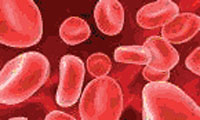Blood cells and plasma
Blood is a fluid comprising red blood cells (see Figure 1.1), several types of white blood cells and small fragments of blood cells called platelets, which are involved in the blood clotting process. These cells are all suspended in yellowish or straw-coloured liquid called plasma. The red blood cells contain a protein called haemoglobin, which is red in colour and contains a lot of iron. The haemoglobin picks up oxygen as the blood passes through the lungs and distributes it around the body.
The blood cells all have medical names, but in this module we will use the names that will mean more to your clients. But for your own information, the medical name for red blood cells is erythrocytes and for white blood cells it is leukocytes.

What do you think is the main function of the red blood cells?
To transport oxygen and deliver it to the body's tissues. It is the haemoglobin in the red blood cells that plays a central role in delivering oxygen to the tissues of the body.
White blood cells are cells of the immune system involved in defending the body against infectious diseases. The number of white blood cells increases whenever someone is infected by disease-causing bacteria or viruses; the increase in number shows how seriously the disease is being fought against by the white blood cells.
The number of red blood cells and white blood cells and the concentration of haemoglobin is an important indicator of a person's health. The levels can be determined from a blood sample analysed at the higher health facilities, including counting the cells by looking at them with a microscope. Table 1.1 shows the typical values for a healthy person.
Table 1.1 Blood analysis data.
| Blood component | Healthy values |
|---|---|
| Red blood cells |
Male 4.3–5.9 x 1012/litre Female 3.5–5 x 1012/litre Or approximately 300 to 600 million red blood cells in every 1 ml of blood plasma (1012 is a mathematical abbreviation for 1,000,000,000,000.) |
| White blood cells |
3.8–9.8 x 109/litre Or approximately 400 to 1,000 million white blood cells in every 1 ml of blood plasma |
| Haemoglobin |
Male 13.8–17.5g/decilitre Female 12.1–15.3g/decilitre Every 1 ml of blood contains between 1–2 grams of haemoglobin One decilitre is one-tenth of a litre (the same as 100 ml). |